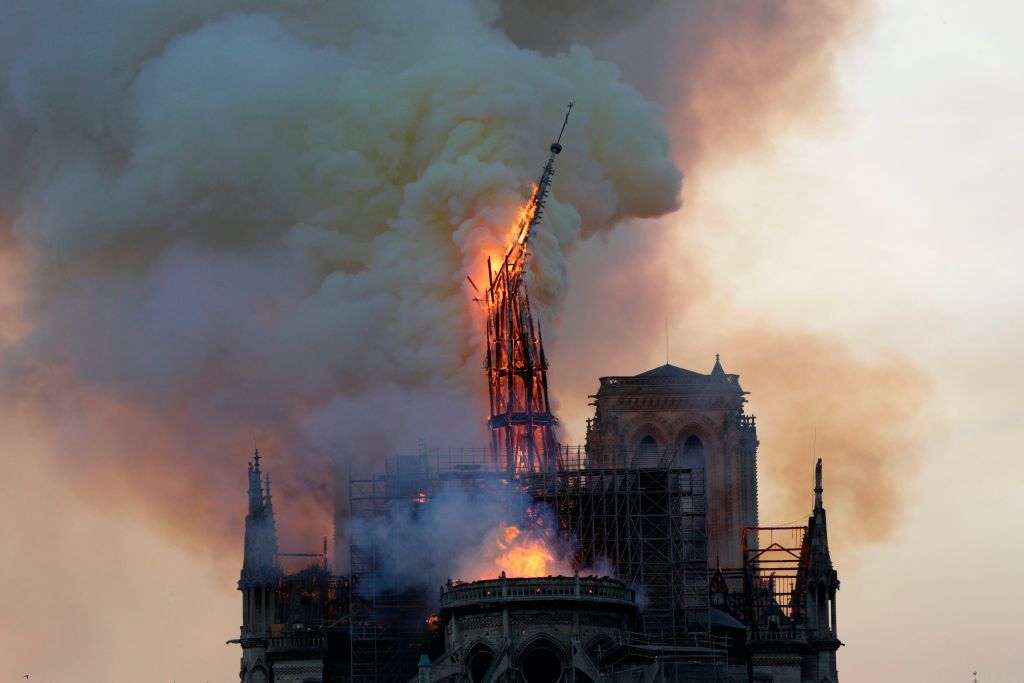
After months of debate, France has decided to stick to tradition in reconstructing Paris’s Notre Dame Cathedral, rather than replacing the 19th-century spire with a contemporary design.
Designed by French architect Eugene Viollet-le-Duc, the spire collapsed in the April 2019 blaze that tore through the church’s wooden attic. Wrongly identified as a false alarm, the fire raged unchecked for close to a half hour before firefighters were called to the scene.
By that time, the wooden timbers of “The Forest,” as the attic was sometimes called, were almost beyond saving. Firefighters focused much of their energies on salvaging the cathedral’s Gothic belfry towers from collapse. As they fought to combat the flames, the 800-ton, 305-foot-tall lead-coated spire crashed through the vaulted stone ceiling, tumbling to the cathedral floor.
Extinguishing the conflagration took nine hours.
View of Notre Dame Cathedral in Paris. Photo by Robin Utrecht/Echoes Wire/Barcroft Studios/Future Publishing/Getty Images.
In the immediate aftermath of the disaster, President Emmanuel Macron promised that the cathedral would be rebuilt within five years—in time for the 2024 Olympics in Paris—and announced that there would be an international architectural competition to redesign the spire, which was added to the 13th-century cathedral in 1859.
“A contemporary architectural gesture” could make Notre-Dame “even more beautiful,” said Macron.
The idea was met with skepticism from numerous architects, conservationists, and academics, and polls showed that the majority of Parisians favored restoring Viollet-le-Duc’s design. (The original spire, built between 1220 and 1230, fell into disrepair and was dismantled in the late 1700s.)
The French Senate passed a bill requiring that the reconstruction be faithful to its “last known visual state,” and Philippe Villeneuve, the cathedral’s chief architect, even threatened to resign if Notre-Dame was not rebuilt the way it was. He clashed with Jean-Louis Georgelin, the army general in charge of the reconstruction, who favored a modern replacement spire, during a meeting of the National Assembly’s cultural affairs committee in November.
Notre-Dame de Paris, 2019. Photo courtesy of the World Monuments Fund.
Macron’s change of heart follows the recommendation of the National Heritage and Architecture Commission, an advisory body for restoration projects, which met last week and heard testimony from Villeneuve.
The committee said that recreating the previous appearance of the cathedral would “guarantee the authenticity, the harmony, and the coherence of this masterpiece of Gothic architecture.” That also includes eschewing modern, potentially safer materials—even though the 460 tons of toxic lead coating the fallen spire posed a major health risk to Parisians. (Wood, on the other hand, might be safer than you’d expect.)
Macron “has become convinced of the need to restore Notre Dame de Paris in the most consistent manner possible to its last complete, coherent and known state,” read a statement from the Elysée Palace, the president’s official residence. Instead, the city will pursue another “contemporary gesture” in the “redevelopment of the surroundings of the cathedral.”
Stockholm studio Ulf Mejergren Architects reenvisioned Notre Dame’s roof as a giant swimming pool. Image courtesy of Ulf Mejergren Architects.
Proposals for a new spire had come in from around the world, reimagining the structure ways ranging from Studio NAB’s plan for a greenhouse with an actual forest and Ulf Mejergren’s rooftop swimming pool.
British architect Norman Foster presented a design for a glass roof with a crystal spire; Brazilian architect Alexandre Fantozzi’s designed one entirely of stained glass; the Slovakian firm Vizum Atelier suggested a light beam piercing the heavens—a goal of Gothic architects—while French designer Mathieu Lehanneur favored a 300-foot gold leaf-covered carbon fiber flame commemorating the fire.
Proposals for rebuilding the roof and spire of Notre Dame Cathedral Paris. Images courtesy of Vizum Atelier; Nicolas Abdelkader/Studio NAB; Alexandre Chassang/ABH Architectes; Alexandre Fantozzi/AJ6; Mathieu Lehanneur; Dakis Panayiotou/Kiss the Architect.
Work on the fire-damaged building has been delayed at various points due to extreme heat, concerns about lead pollution, and the recent two-month shutdown of Paris. An architectural competition could have potentially drawn out the process even longer, jeopardizing Macron’s tight timeline.
Last month, workers finally began removing the 200 tons of twisted metal scaffolding, melted by the flames, that had been in place around the cathedral due to an in-progress restoration project.